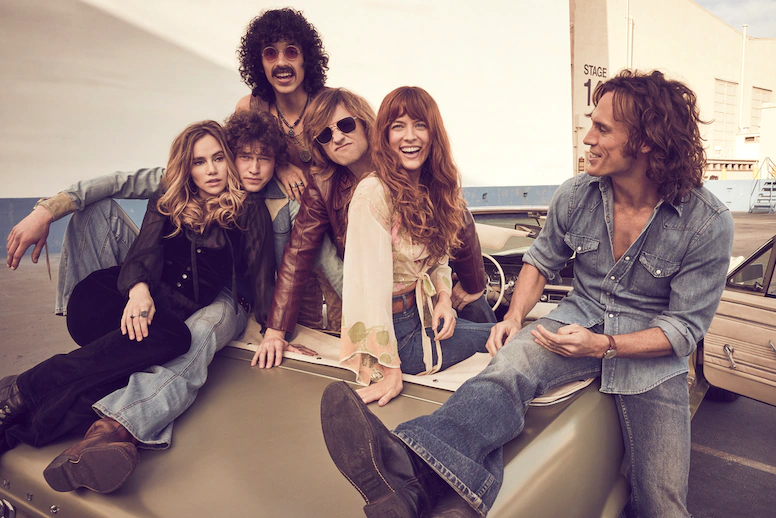Daisy Jones and the Six: window to the 70’s
May 16, 2023
The Amazon Prime Video mini-series “Daisy Jones & the Six,” based on the novel of the same name by Taylor Jenkins-Reid, tells the tale of a fictional band’s ascension to fame and ultimate downfall in the 1970’s. Through original music, a talented cast, and distinct outfits, it is an enjoyable watch. However, any central message it attempts to get across is lost in a daze of romanticization and sun-soaked lighting.
Both the show and book follow an oral history format. The show has established itself among other nostalgic depictions of early 60’s and 70’s Los Angeles, such as the movie “Almost Famous.” Taylor Jenkins-Reid’s main inspiration was the soft rock band Fleetwood Mac. Dynamics between characters like Daisy Jones, played by Riley Keough, and Billy Dunne, played by Sam Claflin, mirror the tumultuous yet passionate relationship of Fleetwood Mac’s Stevie Nicks and Lindsay Buckingham. Even British keyboardist Karen Sirko, played by Suki Waterhouse, is a nod to Christine McVie.
The fascinating aspect of Daisy Jones and the Six that translated well on screen is the nature of human storytelling and unreliable narration. Each band member recounts their own experiences, which at times conflict. Due to a mix of scenes akin to documentary interviews and lengthy flashbacks, the audience is able to see “what really happened.” Familiarity with the book adds depth to the screenplay. To illustrate, Daisy’s iconic declaration, “I had absolutely no interest in being somebody else’s muse. I am not a muse. I am the somebody,” is more of a plea to be believed in the show, not a manifesto. Additional examples involve Camila, beloved wife of Billy, played by Camila Morrone, powerfully setting Billy straight or Billy and Daisy sharing several kisses. A corresponding scene occurs between Camila and Billy in the series but fans were furious when some particularly searing lines were cut or the fact that Daisy and Billy’s relationship was not strictly emotional. A few fans believed these were integral aspects of their personalities. In actuality, that is what makes it believable. The characters are being interviewed 20 years later, each adding comebacks that they wish were said or not revealing certain memories. Eventually, the line between personal recollection and partial truth is blurred. It is an extremely common phenomena.
Daisy Jones is the designated female lead and free spirit archetype. She grows up rich, yet unloved. Daisy enters the music scene on the Sunset Strip as a doe-eyed teenager equipped with a signature red songwriting journal, afghan coat, and flowy blouses. She finds a best friend in queer disco singer Simone Jackson, played by Nabiyah Be. The golden thread that sews Daisy and “The Six” together is legendary producer and consequent father figure Teddy Price, played by Tom Wright. While Daisy is undeniably talented and not quite a manic pixie dream girl, she does not possess a true sense of agency. Towards the final episodes, her actions are based on the men around her.
Daisy Jones and The Six attempts to exhibit the seedy underbelly of the 70’s through the constantly overdosed state of Daisy and Billy. Regrettably, it alludes to serious topics but sanitizes them by lacking nuance. The original bassist Chuck Loving simply becomes a dentist. In the novel he dies after being deployed in the highly protested Vietnam War. The show still chooses to call the band “The Six” even though there are only five members, lazily implying that the sixth member is Camila due to her large role as the band’s photographer. The most deplorable choice the writers make is glossing over Daisy’s sexual assault at the hands of a musician. There was a missed opportunity to make a comment on the problematic nature of groupie culture, instead it blames a part of Daisy’s insecurities on her parents and reiterates that she is not a muse.
The music of Daisy Jones and The Six breathes life into the show. Aurora, the album the band collaborates on, pays homage but cannot even begin to compete with Fleetwood Mac’s acclaimed album “Rumors.” As it happens, both albums were recorded in the renowned recording studio Sound City. Astonishingly, each of the actors are actually playing their instruments. Prior to shooting, they participated in a six-month long band camp. Despite being the grand-daughter of Elvis, Keough had never publicly sung before her role and took voice lessons along with Claflin. The most exceptional songs on the album include “The River,” “Look At Us Now (Honeycomb),” “Two Against Three,” and “Let Me Down Easy.” “The River” is undoubtedly the best track as it encapsulates a classic rock sound without an obvious modernized interpretation. Pieces like “Two Against Three” also allow the album to be composed of tender acoustic ballads.
The live performances and concerts drive the plot forward and deliver some of the more compelling portrayals. On the stage is where Daisy Jones truly emulates the layered-and draped look of Stevie Nicks, complete with a tambourine and mounds of cocaine. Every passionate feeling is witnessed as members communicate through the music. Bathed in stage lights is where the mystic nature of the performances are conjured.
The climax of the show is the infamous split following a pivotal concert in Chicago. Every character endures the fallout of their actions. The series’ continuous focus is Daisy and Billy’s emotional affair. While audience members wish there was more screen time for Karen and Graham’s, guitarist brother of Billy played by Will Harrison, ill-fated relationship or Warren’s, drummer played by Sebastian Chacon, fresh personality, Daisy and Billy possess a particular level of chemistry and complexity. Their relationship juxtaposes the one between Camila and him. Admiringly, Camila does not take on the archetype of the passive wife. She is a nurturing mother to their daughter Julia but has aspirations and decides to have her own brief affair with Eddie, bassist played by Sebastian Chacon, who continues to pine after her. Daisy and Billy are twin flames, burning for the same things. They suffer from the same addictions and consider themselves to be broken people. Without healing, they are destructive and selfish. Their initial tension grows into an exploration of the intimacy of being understood.
In the end, Billy chooses who he believes to be his peace and water, instead of his fire. In spite of everything, Daisy and Camila do not harbor any bitterness towards one another. In fact, they have a unique sense of hope and respect for each other outside their connection to Billy. The demonstration of female support systems and friendships is one of the most appealing facets in the storyline. Every woman is a subtle ally. It is a refreshing contrast to Billy’s controlling actions and the marketed “intense” love-triangle.
The advertised plot twist is that Julia has been conducting the interviews. Soon after them, Camila tragically passed away from a terminal illness, instructing Billy to, “Give Daisy Jones a call.” In the moment, the final scenes are tear-jerkers. Yet upon reflection they are a simple solution to the messy environment that has been built for the previous 9 episodes. Did anyone actually suffer from the consequences of their actions, especially Billy? The future is left open ended. Overall, paralleling Daisy, the show is difficult to not love despite its flaws.



